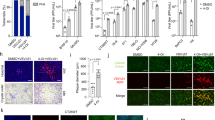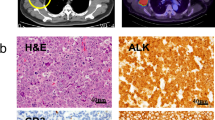Abstract
We used a recombinant retrovirus as one of the potential vectors for human gene therapy to transfer a drug sensitivity gene into human lung cancer cells. The gene encoding the thymidine kinase (TK) of herpes simplex virus type 1 (HSV1) was used as the drug sensitivity gene. The antiherpes drugs acyclovir (ACV) and ganciclovir (GCV) were chosen to test the HSV1-TK activity transferred into the human lung cancer cell lines. The rationale for this approach was that ACV and GCV are nucleoside analogs specifically converted by HSV1-TK to a toxic form capable of inhibiting DNA synthesis or disrupting cellular DNA replication. The results obtained from our experiments demonstrate that the retroviral vector-mediated HSV1-TK gene transfer leads to ACV- and GCV-dependent cytotoxicity in human lung cancer cell lines, including both small-cell carcinoma and nonsmall-cell carcinoma. Although the gene transfer of HSV1-TK gene into tumor cells would be one model for gene therapy to control lung cancer, further investigations are necessary for the proper choice of the therapeutic gene and vector targeting such as tumor cell specific delivery of the gene or tumor cell specific expression of the transduced gene.
Similar content being viewed by others
Abbreviations
- ACV :
-
Acyclovir
- GCV :
-
Ganciclovir
- HSV1 :
-
Herpes simplex virus type 1
- LTR :
-
Long terminal repeat
- TK :
-
Thymidine kinase
References
Anderson WF (1992) Human gene therapy. Science 256:808–813
Miller AD (1992) Human gene therapy comes of age. Nature 357:455–460
Friedmann T (1989) Progress toward human gene therapy. Science 244:1275–1281
DeVita VT jr, Hellman S, Rosenberg SA (1993) Cancer: principles and practice of oncology, 4th edn. Lippincott, Philadelphia
Miller AD, Rosman GJ (1989) Improved retroviral vectors for gene transfer and expression. BioTechniques 7:980–990
Miller AD, Buttimore C (1986) Redesign of retrovirus packaging cell lines to avoid recombination leading to helper virus production. Mol Cell Biol 6:2895–2902
Yee LJ-K, Wolff JA, Friedmann T (1989) Factors affecting long-term stability of Moloney leukemia virus-based vectors. Virology 171:331–341
McKnight SL, Gavis ER, Kingsbury R, et al (1981) Analysis of transcriptional regulatory signals of the HSV thymidine kinase gene: identification of an upstream control region. Cell 25:385–398
Abe A, Takeo T, Emi N, et al (1993) Transduction of a drug-sensitive toxic gene into human leukemia cell lines with a novel retroviral vector. Proc Soc Exp Biol Med 203:354–359
Hasegawa Y, Emi N, Shimokata K, et al (1993) Gene transfer of herpes simplex virus type I thymidine kinase gene as a drug sensitivity gene into human lung cancer cell lines using retroviral vectors. Am J Respir Cell Mol Biol 8:655–661
Miller AD, Law MF, Verma IM (1985) Generation of helper-free amphotropic retroviruses that transduce a dominant-action, methotrexate-resistant dihydrofolate reductase gene. Mol Cell Biol 5:431–437
Mann R, Mulligan RC, Baltimore D (1983) Construction of a retrovirus packaging mutant and its use to produce helper-free defective retrovirus. Cell 33:153–159
Quade K (1979) Transformation of mammalian cells by avian myelocytomatosis virus and avian erythroblastosis virus. Virology 98:461–465
Miyanohara A, Sharkey MF, Witztum JL, et al (1988) Efficient expression of retroviral vector-transduced human low density lipoprotein (LDL) receptor in LDL receptor-deficient rabbit fibroblasts in vitro. Proc Natl Acad Sci USA 85:6538–6542
Emi N, Friedmann T, Yee J-K (1991) Pseudotype formation of murine leukemia virus with the G protein of vesicular stomatitis virus. J Virol 65:1202–1207
Burns JC, Friedmann T, Driever W et al. (1993) Vesicular stomatitis virus G glycoprotein pseudotyped retroviral vectors: concentration to very high titer and efficient gene transfer into mammalian and nonmammalian cells. Proc Natl Acad Sci USA 90:8033–8037
Rousculp MD, Goldsmith KT, Garver RI jr (1992) Quantitative evaluation of retroviral gene transduction efficiency in human lung cancer cells. Hum Gene Ther 3:471–477
Kotin RM, Siniscalco M, Samulski RJ et al (1990) Site-specific integration by adeno-associated virus. Proc Natl Acad Sci USA 87:2211–2215
Samulski RJ, Zhu X, Xiao X et al (1991) Targeted integration of adeno-associated virus (AAV) into human chromosome 19. EMBO J 10:3941–3950
Price J, Turner D, Cepko C (1987) Lineage analysis in the vertebrate nervous system by retrovirus-mediated gene transfer. Proc Natl Acad Sci USA 84:156–160
Rosenberg SA, Aebersold P, Cornetta K, et al (1990) Gene transfer into humans-immunotherapy of patients with advanced melanoma, using tumor-infiltrating lumphocytes modified by retroviral gene transduction. N Engl J Med 323:570–578
Rosenberg SA (1991) Immunotherapy and gene therapy of cancer. Cancer Res [Suppl] 51:5074s-5079s
Huang H-JS, Yee J-K, Shew J-Y, et al (1988) Suppression of the neoplastic phenotype by replacement of the RB gene in human cancer cells. Science 242:1563–1566
Baker SJ, Markowitz S, Fearon ER, et al (1990) Suppression of human colorectal carcinoma cell growth by wild-type p53. Science 249:912–915
Fearon ER, Pardoll DM, Itaya T, et al (1990) Interleukin-2 production by tumor cells bypasses T helper function in the generation of an antitumor response. Cell 60:397–403
Ohe Y, Podack ER, Olsen KJ, et al (1993) Combination effect of vaccination with IL2 and IL4 cDNA transfected cells on the induction of a therapeutic immune response against Lewis lung carcinoma cells. Int J Cancer 53:432–437
Hunt JD, Pippin BA, Landreneau RJ, et al (1993) Transfer and expression of the human interleukin-4 gene in carcinoma and stromal cell lines derived from lung cancer patients. J Immunother 14:314–321
Isobe K, Hasegawa Y, Iwamoto T, et al (1989) Induction of antitumor immunity in mice by allo-major histocompatibility complex class I gene transfectant with strong antigen expression. J Natl Cancer Inst 81:1823–1828
Cheng Y-C, Dutschman G, Fox JJ, et al (1981) Differential activity of potential antiviral nucleoside analogs on herpes simplex virus-induced and human cellular thymidine kinases. Antimicrob Agents Chemother 20:420–423
Nishiyama Y, Rapp F (1979) Anticellular effects of 9-(2-hydroxyethoxymethyl) guanine against herpes simplex virus-transformed cells. J Gen Virol 45:227–230
Furman PA, McGuirt PV, Keller PM, et al (1980) Inhibition by acyclovir of cell growth and DNA synthesis of cells biochemically transformed with herpes virus genetic information. Virology 102:420–430
Davidson RL, Kaufman ER, Crumpacker CS, et al (1981) Inhibition of herpes simplex virus transformed and nontransformed cells by acycloguanosine: mechanisms of uptake and toxicity. Virology 113:9–19
Moolten FL (1986) Tumor chemosensitivity conferred by inserted herpes thymidine kinase genes: paradigm for a prospective cancer control strategy. Cancer Res 46:5276–5281
Moolten FL, Wells JM (1990) Curability of tumors bearing herpes thymidine kinase genes transferred by retroviral vectors. J Natl Cancer Inst 82:297–300
Ezzeddine ZD, Martuza RL, Platika D et al (1991) Selective killing of glioma cells in culture and in vivo by retrovirus transfer of the herpes simplex virus thymidine kinase gene. New Biologist 3:608–614
Elion GB, Furman PA, Fyfe JA et al (1977) Selectivity of action of an antiherpetic agent, 9-(2-hydroxyethoxymethyl) guanine. Proc Natl Acad Sci USA 74:5716–5720
Field AK, Davies ME, DeWitt C et al (1983) 9-{[2-Hydroxy1-(hydroxymethyl)ethoxy]methyl} guanine: a selective inhibitor of herpes group virus replication. Proc Natl Acad Sci USA 80:4139–4143
Ashton WT, Karkas JD, Field AK et al (1982) Activation by thymidine kinase and potent antiherpetic activity of 2′-nor-2′deoxyguanosine (2′NDG). Biochem Biophys Res Commun 108:1716–1721
Matthews T, Boehme R (1988) Antiviral activity and mechanism of action of ganciclovir. Rev Infect Dis 10 [Suppl 3]: 490–494
Cheng Y-C, Huang E-S, Lin J-C et al (1983) Unique spectrum of activity of 9-[(1, 3-dihydroxy-2-propoxy)methyl]-guanine against herpes viruses in vitro and its mode of action against herpes simplex virus type 1. Proc Natl Acad Sci USA 80:2767–2770
Culver KW, Ram Z, Wallbridge S et al (1992) In vivo gene transfer with retroviral vector-producer cells for treatment of experimental brain tumors. Science 256:1550–1552
Curiel DT, Agarwal S, Unni Romer M et al (1992) Gene transfer to respiratory epithelial cells via the receptor-mediated endocytosis pathway. Am J Respir Cell Mol Biol 6:247–252
Mizuno M, Yoshida J, Sugita K et al (1990) Growth inhibition of glioma cells transfected with the human β-interferon gene by liposomes coupled with a monoclonal antibody. Cancer Res 50:7826–7829
DiMaio JM, Clary BM, Via DF et al (1994) Directed enzyme pro-drug gene therapy for pancreatic cancer in vivo. Surgery 116:205–213
Smith MJ, Rousculp MD, Goldsmith KT et al (1994) Surfactant protein A-directed toxin gene kills lung cancer cells in vitro. Hum Gene Ther 5:29–35
Author information
Authors and Affiliations
Rights and permissions
About this article
Cite this article
Hasegawa, Y., Emi, N. & Shimokata, K. Retroviral transfer of HSV1-TK gene into human lung cancer cell line. J Mol Med 73, 107–112 (1995). https://doi.org/10.1007/BF00198237
Published:
Issue Date:
DOI: https://doi.org/10.1007/BF00198237




